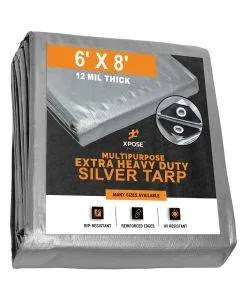Poly Tarps: Versatile Protection for Every Need
Poly tarps, short for polyethylene tarps, are versatile and durable covers that find application across a spectrum of industries and activities. Whether safeguarding equipment, shielding materials from the elements, or creating temporary shelters, poly tarps are indispensable. In this article, we'll explore the diverse uses, benefits, and considerations associated with poly tarps, showcasing their role as versatile protection solutions.
Understanding Poly Tarps:
Poly tarps are crafted from polyethylene, a thermoplastic material known for its robustness, flexibility, and resistance to various environmental factors. The manufacturing process involves weaving or knitting polyethylene strands together and then coating the fabric with a layer of polyethylene. This results in a sturdy, water-resistant, and UV-resistant material that is highly adaptable.
Key Uses of Poly Tarps:
Construction Sites: Poly tarps are commonly employed on construction sites to protect building materials, machinery, and equipment from rain, sun, and debris. Their durability ensures that essential items remain in optimal condition, minimizing the risk of damage or deterioration.
Agriculture and Farming: In agriculture, poly tarps serve multiple purposes. They can function as ground covers for weed control, protect crops from adverse weather conditions, and create temporary shelters for animals or equipment. The UV-resistant properties of poly tarps contribute to their longevity in outdoor settings.
Home Improvement Projects: Homeowners utilize poly tarps during various home improvement projects. From covering furniture during painting or renovation work to safeguarding firewood from the elements, these tarps offer a convenient and cost-effective solution for protecting possessions.
Transportation and Cargo: Poly tarps play a crucial role in the transportation industry, providing cover for cargo on trucks or trailers. Waterproof poly tarps protect goods from rain and snow during transit, ensuring that shipments arrive at their destination in optimal condition.
Recreational Use: Campers, hikers, and outdoor enthusiasts often rely on poly tarps for makeshift shelters, ground covers, or protective canopies. Their lightweight and compact nature make them an ideal choice for those seeking versatile and portable solutions in the great outdoors.
Benefits of Poly Tarps:
Durability: Poly tarps are known for their durability and resilience. They can withstand exposure to sunlight, rain, and wind without degrading, making them a reliable choice for long-term outdoor use.
Water Resistance: The water-resistant nature of poly tarps ensures that they effectively protect items from rain and moisture. This feature is particularly valuable in applications where keeping the contents dry is paramount.
UV Resistance: The UV-resistant coating on poly tarps prevents degradation caused by prolonged exposure to sunlight. This characteristic extends the lifespan of the tarps, making them suitable for outdoor applications in various climates.
Affordability: Poly tarps are cost-effective compared to some alternative materials. Their affordability, combined with their versatility, makes them a practical choice for a wide range of applications.
Ease of Use: With grommets or reinforced edges for securing, poly tarps are easy to install and remove. Their lightweight design and flexibility make them manageable for individuals with varying levels of physical strength.
Considerations When Choosing Poly Tarps:
Thickness and Weight: blue poly tarps come in different thicknesses and weights, each suitable for specific applications. Thicker tarps offer enhanced durability but may be heavier and less flexible.
Grommet Placement: The placement and quality of grommets play a role in the tarp's effectiveness. Ensure that the grommets are strategically located for secure tie-down options.
Color Options: Poly tarps are available in various colors, each with specific advantages. For example, darker colors may offer better UV resistance, while lighter colors may reflect sunlight, reducing heat absorption.
Size and Dimensions: Consider the size and dimensions of the poly tarp in relation to the area or items you need to cover. Choosing the right size ensures effective protection.

Comments
Post a Comment